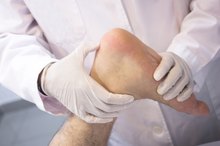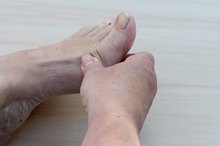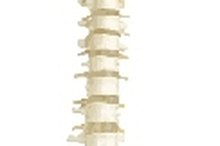Cheek Bone Diseases
Many diseases can affect the cheek bones. According to the U.S. National Library of Medicine and the National Institutes of Health or NIH, face pain—which includes cheek pain—can be dull and throbbing or intense and stabbing, and it can be felt on one or both sides of the face 1. The NIH states that face pain may manifest for no apparent reason, or it may be caused by a nerve disorder, trauma or infection. Sometimes problems arise in the zygomatic bone or the other bones that help form the cheek.
Temporomandibular Joint Disorder
Temporomandibular joint disorder is a disease associated with the cheek bones. According to the National Institute of Dental and Craniofacial Research or NIDCR, a division of the National Institutes of Health, temporomandibular joint disorder or TMD is a condition that causes face pain and jaw dysfunction 1. The NIDCR estimates that over 10 million Americans are affected by TMD which is more common in women than men.
The temporomandibular joint connects the lower jaw to the skull's temporal bone. Derangement or damage to the disc in the temporomandibular joint can involve a displaced disc, dislocated jaw or injury to the condyle—the bony prominence that allows the jaw to articulate with the skull.
- Temporomandibular joint disorder is a disease associated with the cheek bones.
- Derangement or damage to the disc in the temporomandibular joint can involve a displaced disc, dislocated jaw or injury to the condyle—the bony prominence that allows the jaw to articulate with the skull.
Burkitt's Lymphoma
Bone Deterioration Diseases
Learn More
Burkitt's lymphoma is another disease associated with the cheek bones. The National Cancer Institute or NCI—a division of the National Institutes of Health—notes that Burkitt's lymphoma is a B-cell non-Hodgkin lymphoma, which means that the cancer affects the body's B lymphocytes 12. B lymphocytes help protect a person against bacteria or viruses by creating antibodies. There are several types of Burkitt's lymphoma, including the endemic variant, which is found in equatorial Africa. According to Drs. The endemic variant of Burkitt's lymphoma is the most common cancer seen among children in equatorial Africa. Cotran and colleagues note that Burkitt's lymphoma responds well to short-term, high-dose chemotherapy.
- Burkitt's lymphoma is another disease associated with the cheek bones.
- There are several types of Burkitt's lymphoma, including the endemic variant, which is found in equatorial Africa.
Osteomyelitis
According to the Cleveland Clinic, one of the top four hospitals in the United States, osteomyelitis is an acute or chronic infection of the bone that affects about one in every 10,000 people 3. Osteomyelitis can affect the cheek bones and may be caused by a variety of microbial agents, including staphylococcus aureus. If left untreated, osteomyelitis can cause reduced blood supply to the involved bone, which can cause the bone tissue to die. The Cleveland Clinic states that osteomyelitis affects both children and adults 3.
Related Articles
References
- National Institutes of Health: Face Pain
- National Cancer Institute: Non-Hodgkin Lymphoma
- Cleveland Clinic: Osteomyelitis
- Dozzo M, Carobolante F, Donisi PM, et al. Burkitt lymphoma in adolescents and young adults: management challenges. Adolesc Health Med Ther. 2017;8:11-29. doi:10.2147/AHMT.S94170
- Magrath I. Denis Burkitt and the African lymphoma. Ecancermedicalscience. 2009;3:159. doi:10.3332/ecancer.2009.159
- Huh J. Epidemiologic overview of malignant lymphoma. Korean J Hematol. 2012;47(2):92-104. doi:10.5045/kjh.2012.47.2.92
- Chettiankandy TJ, Tupkari JV, Kumar K, Ahire MS. B-cell lymphoma, unclassifiable, with features intermediate between diffuse large B-cell lymphoma and classical Burkitt's lymphoma: a case report and review. J Oral Maxillofac Pathol. 2016;20(2):333. doi:10.4103/0973-029X.185936
- Re A, Cattaneo C, Rossi G. Hiv and Lymphoma: from Epidemiology to Clinical Management. Mediterr J Hematol Infect Dis. 2019;11(1):e2019004. doi:10.4084/MJHID.2019.004
- Chen MR. Epstein-barr virus, the immune system, and associated diseases. Front Microbiol. 2011;2:5. doi:10.3389/fmicb.2011.00005
- Laman M, Hwaiwhanje I, Bona C, et al. Viral pathogens in children hospitalized with features of central nervous system infection in a malaria-endemic region of Papua New Guinea. BMC Infect Dis. 2014;14:630. doi:10.1186/s12879-014-0630-0
- Rafael Pharmaceuticals, Inc. Burkitt’s Lymphoma: From Diagnosis to Treatment
- Costa LJ, Xavier AC, Wahlquist AE, Hill EG. Trends in survival of patients with Burkitt lymphoma/leukemia in the USA: an analysis of 3691 cases. Blood. 2013;121(24):4861–4866. doi:10.1182/blood-2012-12-475558
- Coghill, A., and A. Hildesheim. Epstein-Barr virus antibodies and the risk of associated malignancies: a review of the literature. American Journal of Epidemiology. 2014. 180(7):687-95.
- Dunleavy, K., Pittaluga, S., Shovlin, M, et al. Low-intensity therapy in adults with Burkitt’s lymphoma. The New England Journal of Medicine. 2013. 369(20):1915-25.
- National Cancer Institute. PDQ Cancer Information Summaries. Child Non-Hodgkin Lymphoma Treatment (PDQ). Health Professional Version. 09/29/15.
Resources
- "Pathologic Basis of Disease"; Ramzi S. Cotran, M.D. et al.; 1999
Writer Bio
Martin Hughes is a chiropractic physician, health writer and the co-owner of a website devoted to natural footgear. He writes about health, fitness, diet and lifestyle. Hughes earned his Bachelor of Science in kinesiology at the University of Waterloo and his doctoral degree from Western States Chiropractic College in Portland, Ore.








